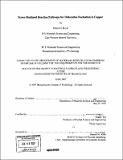Stress-mediated reaction pathways for dislocation nucleation in copper
Author(s)
Boyer, Robert D. (Robert Damian), 1978-
DownloadFull printable version (10.84Mb)
Other Contributors
Massachusetts Institute of Technology. Dept. of Materials Science and Engineering.
Advisor
Sidney Yip.
Terms of use
Metadata
Show full item recordAbstract
The ductile behavior of metals requires dislocation nucleation, from either homogeneous or heterogeneous sources, in order to produce the large number of dislocations necessary for extensive plastic deformation. As with the majority of the defect processes that comprise deformation and failure of materials, dislocation nucleation is well described in the framework of transition state theory as a stress-mediated, thermally activated process. We have used reaction pathway sampling methods and well-fit empirical potentials to determine the stress-dependent behavior of and atomistic mechanisms for dislocation nucleation at stresses much lower than typically accessible to atomistic techniques. We have shown that a significant range of stresses exist for which homogeneous dislocation loop nucleation is feasible because the critical nucleate transitions to an in-plane shear perturbation where the shear displacement of most particles is significantly less than the Burger's vector. We have also revealed that the common structural conception of activation volume for dislocation nucleation does not apply for all stresses and in general over-predicts the stress-dependence of activation by considering only the shear displacement of the critical defect. (cont.) Furthermore, by considering the full reaction pathway for dislocation nucleation in perfect crystals and at a vacancy, we have provided a fully atomistic description of shear localization via an expanded one-dimensional chain analysis of the wave-steepening behavior. Lastly, both breaking the local atomic symmetry and increasing the extent of heterogeneous nucleation sites are shown to lower the activation energy for dislocation nucleation. In general we have applied reaction pathway sampling to the problem of dislocation nucleation in Cu not only for a perfect crystal, but also in the presence of point defects, vacancy clusters and nanowire surfaces. As a result the strength of a variety of nucleation sites in mediating activation as well as specific atomistic mechanisms for dislocation nucleation have been discussed from both structural and energetic perspectives.
Description
Thesis (Ph. D.)--Massachusetts Institute of Technology, Dept. of Materials Science and Engineering, 2007. Includes bibliographical references (p. 111-119).
Date issued
2007Department
Massachusetts Institute of Technology. Department of Materials Science and EngineeringPublisher
Massachusetts Institute of Technology
Keywords
Materials Science and Engineering.